Inspiring Generations event focuses on contributing to society and collaboration
28 March 2023
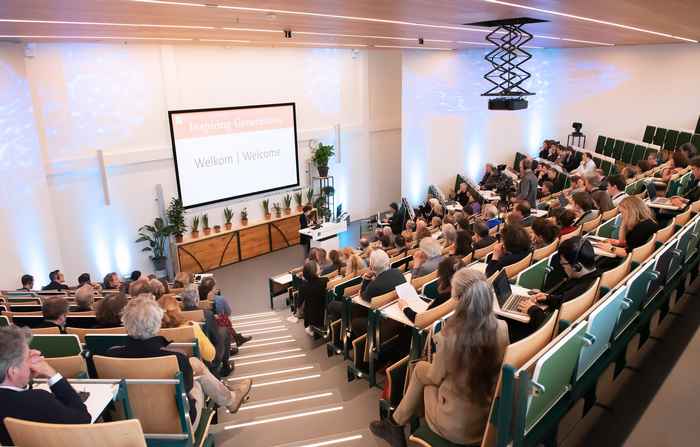
On 20 March, the second edition of the Inspiring Generations event was held at the Amsterdam Science Park in LAB42. Here, 135 representatives from the Executive Board, faculties, services and allied organisations discussed the aims and initiatives contained in the UvA Strategic Plan. The goal of this event was to strengthen the knowledge, involvement and contributions of senior management regarding the UvA’s strategic course and to facilitate mutual collaboration.
Since some of the themes discussed at this event are also important to staff and students who were unable to attend, we here provide a summary of what was discussed.
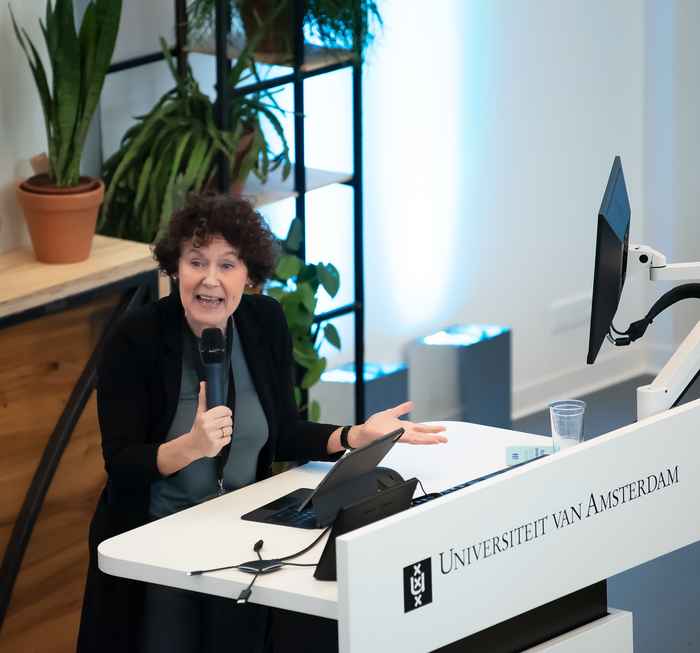
Theme-based collaboration
The event was opened by Executive Board President Geert ten Dam, who talked about how science can contribute to themes such as sustainability, health, digitalisation and justice. ‘First of all, this requires scientific renewal,’ said Geert. ‘Our unique position as a broad-based, pioneering institution puts us in an excellent position to contribute here. But this is not something we can do by ourselves: collaboration within the UvA as well as with external partners is crucial.’
In the Strategic Plan, the theme-based approach is shaped around four interdisciplinary themes: responsible digital transformations, a healthy future, a fair and resilient society and sustainable prosperity. ‘We needed some time to build up steam, but we see that staff from different faculties are becoming increasingly able to connect. The UvA Sustainability Platform, which among other things organises a monthly get-together, is a good example of this.’
Amsterdam AI Coalition
But how do you get collaboration off the ground? As an example, Geert talked about the Amsterdam AI Coalition. ‘Three years ago, we joined forces: this began with monthly breakfast sessions and is now firmly anchored in an Amsterdam AI partnership. Working on the basis of mutual trust and aiming to grant each other benefits, consortia have now been formed in collaboration with the municipality, ministries and the business community. The opening of LAB42 last year was another step that marked the goals and possibilities of collaboration. We will continue doing what we’re good at, but in order to create further impact, we are joining forces and building broader coalitions. However, we also need to make these coalitions visible,’ concluded Geert. ‘That way, the outside world can see what we’re doing and partners can approach us, which in turn will generate new collaborations.’
How do you achieve collaboration?
Geert drew on her own experience to describe how collaboration often literally begins by getting in touch with each other and exploring how you can strengthen each other. ‘You simply need to approach people. Also, be aware that help is available from IXA. Business developers can be a huge help in seeking contacts and developing partnerships. Two weeks ago, at the Executive Board we decided to allocate a million euros a year for better support of valorisation.’
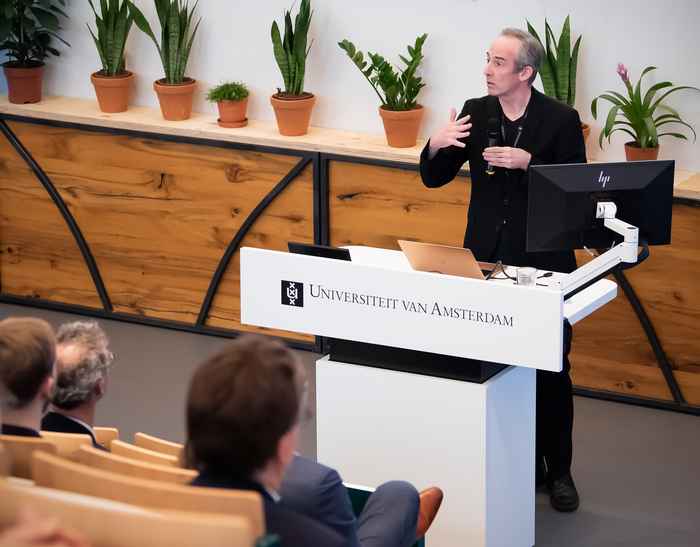
Experiences of the Innovation Center for Artificial Intelligence (ICAI)
The second speaker was Maarten de Rijke, University Professor of AI and Information Retrieval, who was also the host on behalf of LAB42. He recounted that the UvA has been active in the field of data science and AI since the mid-1980s but that a problem arose around 2014: ‘If AI is soon to be found in all the capillaries of society, how will we ensure that we ourselves are sufficiently able to control things?’ This is important, because major shifts involving AI are chiefly in the hands of major tech companies.
‘In order to tackle this problem, you need three things,’ said Maarten: ‘Shared ownership, so that the people who are influenced by technology also have influence on this technology; you shouldn’t replace human intelligence but support it; and you need to ensure that you take various types of “voices” on board. This is what we’re doing at the Innovation Center for Artificial Intelligence with an ecosystem of labs.’ By now, this has grown to comprise 47 labs with 300+ doctoral researchers and more than 140 partners. These are helping to bring talent to the Netherlands and to retain it here – talent that works on shared research agendas that we link to start-ups.
Maarten closed his speech with the lessons learned. ‘It’s not about transactions but about transformations.’ Setting up collaborative structures takes years. And this requires patience. ‘Give ownership, have trust and over-invest in communication,’ said Maarten. ‘But the most important thing is: get down to work!’
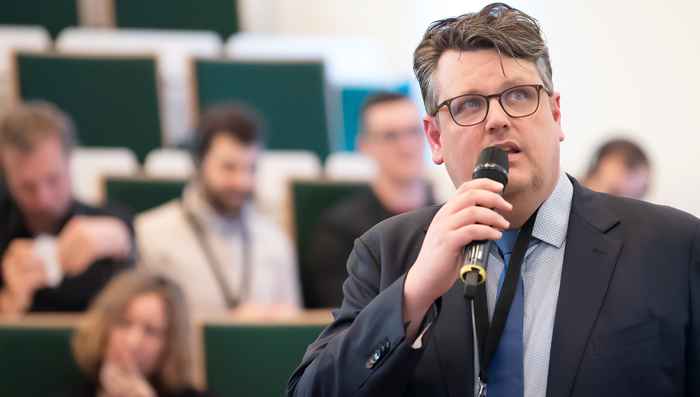
Strategic Plan making progress
Erik Boels, the director responsible for implementing the Strategic Plan, described where we currently stand after two years of working on implementation. ‘During this time, we’ve made major steps towards ensuring that we’ll achieve the Strategic Plan. To give one example, we’ve made sure that very many staff and managers are familiar with what the plan aims to achieve. You can see the ambitions of the Plan being furthered at all faculties and services. They are reflected in the digital agenda, the HR programme, the further development of the themes, faculty strategic plans and moreover at many points in practical action and discussions at the UvA.’
Administrative priorities
‘Each year, together with the deans, the Executive Board sets the administrative priorities for the Strategic Plan. These are topics that need to receive extra attention. Just like last year, we are devoting extra attention to interfaculty, theme-based collaboration,’ explained Erik. ‘Furthermore, there are three new administrative priorities this academic year: strengthening recruitment and retention, further building the technological profile of the UvA and, through a programmatic approach, improving the internal services.’ Regularly check out the web page on the Strategic Plan to keep informed about news on these administrative priorities.
Results of the Strategic Plan becoming visible
Erik continued, ‘It’s important that, in the coming year, we harvest the first fruits of the implementation of the Strategic Plan. This will mean colleagues who are able to interact across faculty boundaries, new partners for collaboration, more space for entrepreneurship and better internal services. Some of these goals have already been achieved, and others will soon be completed. The mid-term review for the Strategic Plan, scheduled for the end of the year, will render the first results visible, and we will see how we can improve the Plan and its implementation. We’ve assigned sufficient funds for achieving the most important goals of the Plan, such as theme-based collaboration and – following on from this – interfaculty teaching.’

A multidisciplinary approach to tackling societal problems
Keynote speaker Wiro Niessen, dean of UMC Groningen, shared his experiences regarding collaboration with Erasmus MC, TU Delft and Health-RI. ‘The future of health care is truly a complex problem. I was always very technology-driven, but in the end, it’s essential to make sure that people actually benefit from all these things. If you ultimately want to create impact, then you have to bring disciplines together. This means not only talking about collaboration within institutions – you really need to consider partnerships between institutions as well.’
This starts with a major societal problem that you can identify with and that you know you can’t solve within just your own discipline. If you set up multidisciplinary research groups, meet each other and regularly talk to each other, you can truly get a lot done, and you get a huge amount of innovation. It really does take a lot of time and effort before you speak each other’s language, but this is precisely what you need to achieve together. And then you realise that, sometimes, you can make wonderful technology-driven plans, but if you don’t truly ask yourself “what are actually the fundamental problems in this society?”, then solutions like these will ultimately be of no use.’
Importance of education and valorisation
‘In this respect, you shouldn’t only consider research, but education and valorisation too: how can we get our work and its results to the citizen or patient? There is often a sort of negative attitude towards collaboration with companies, and it’s only right that we often look very critically at this issue. But if we don’t collaborate with businesses, then almost everything we do will fail to reach any citizens. I think that, if we want to achieve our societal task, we need to collaborate with private partners in a good way. This is something we should be prepared to explain, and something we need to support.’
A little bit multidisciplinary
‘One very important thing is to intensify multidisciplinary teams. This is something we often do in principle, but only to a very slight extent. We get funding when we set up a multidisciplinary project, but the people in a project like this often still remain accountable to their own discipline and managers. And this means that we’re not really intensifying the collaboration in the long term. We definitely need to watch out for this, because otherwise we only encourage and facilitate the people who are pursuing careers along the beaten track.’
The combination of top-down and bottom-up is the only way
‘The most important thing is: just get started. Don’t wait for the big plans – simply begin bringing people together. The things that work are a combination of something that arises bottom-up, because we think “that’s good”, and that also gets real support top-down, so that the people who come up with an idea actually get the mandate to put it into practice. The lessons that I learned myself in the partnership between TU Delft and Erasmus MC boil down to this: if it only takes place top-down, nothing will happen, if it’s only bottom-up, then nothing will happen either; you need to combine the two.’
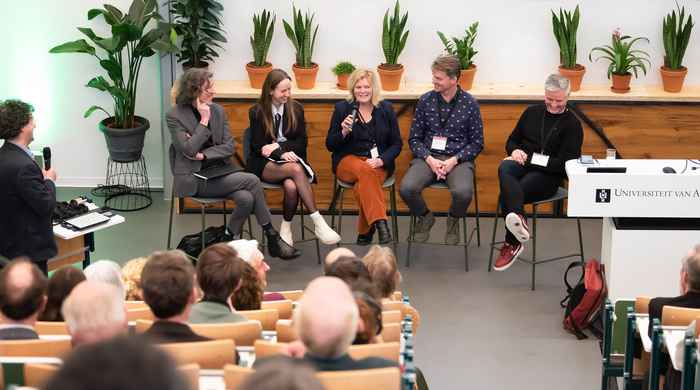
How can the UvA make an optimum contribution to society?
The Inspiring Generations event was rounded off in terms of content by a panel discussion chaired by Rector Magnificus Peter-Paul Verbeek. One of the questions he put to the members of the panel was: how can the UvA make an optimum contribution to tackling societal issues?
Claes de Vreese, university professor of AI and Society, pointed out that society often wishes to hear clear-cut answers to questions such as ‘should TikTok be banned?’ He advocated a differentiation between sharing ‘this is what we currently know’ in the short term and simultaneously working on a model, so that we do not become just a better class of consultants. Bram Orobio de Castro, professor of Child Care and Youth Sciences, added that, in the youth welfare sector, for example, policy is determined by the issues of the day. ‘It’s important that we work together to create a system that continues to learn and hence to shape societal processes in such a way that they include a learning ability.’
Tessa Trapp, president of the Central Student Council, emphasised that, when tackling societal issues, it is important to involve all stakeholders, including students: ‘I think that students should definitely be included in all these questions, because they often have a very different perspective on these issues. We’re often the people who experience the policies and projects, so I think it’s very important to include this perspective.’
André Nollkaemper, dean of the Law School, believes in the importance of outside-in thinking, but he sees a risk as well: ‘In the end, we also need to keep thinking on the basis of our own abilities and our own agenda. This is the constant connection we need to achieve between width and depth within the UvA.’
How can we encourage interdisciplinary collaboration?
Interdisciplinary collaboration begins by establishing contact with each other. ‘The UvA is so big that people can’t connect just on the basis of one theme,’ said Agneta Fischer, dean of the Faculty of Social and Behavioural Sciences. ‘We need measures to show more clearly what people are working on. And once people have started collaborating, we need a good process of reflection and evaluation to see how this interdisciplinary collaboration is progressing.’ Her advocacy of a physical location where people can work together was widely supported. André Nollkaemper said, ‘We need to create encounters. This whole process stands or falls with personal contact: getting to know each other, listening and entering into discussion. We need to facilitate this actively, because it won’t happen by itself.’
Claes de Vreese pointed out that this also needs to be reflected in the appointments policy, ‘At the UvA, we can’t invest in interdisciplinarity while simultaneously investing in disciplinarity when selecting lecturers.’ Bram Orobio de Castro added that the same goes for our degree programmes: it would be good to give students broader access to enable them to shop at each other’s disciplines, and this also includes less obvious courses of studies. The teaching should radiate interdisciplinarity as well.’
Contact
For more information, go to this page on the UvA strategy. If you have any questions about the Inspiring Generations event or the Strategic Plan, or ideas you would like to share, please send an email to instellingsplan@uva.nl.